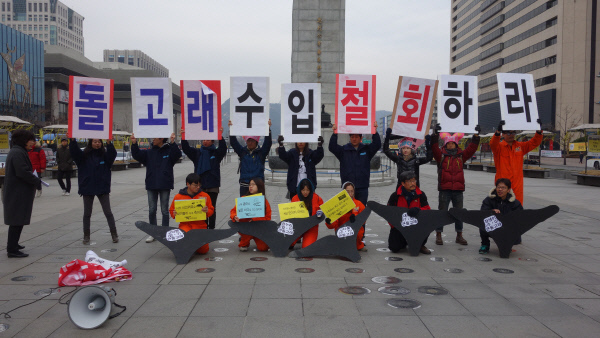Ulsan’s south district office mapped out a plan Friday to enhance the welfare of dolphins locked in the city’s aquarium amid escalating criticism from environmental groups of its attempt to cover up their deaths.

Apologizing for hiding a series of deaths of dolphins at the city’s Whale Life Experience Museum, the office vowed to improve the living conditions for dolphins in captivity and temporarily suspend their import from Japan.
Under the plan, it will make the conditions in the tanks similar to the wild by installing artificial rocks and marine plants. It will invest in developing a program to study dolphins’ behavior and help them live as they do in the wild.
Dolphin shows, in which spectators can feed the marine mammals, will be reduced in frequency from four times a day to three. It also promised to raise the number of dolphin trainers and enhance the animals’ medical check-ups.
But the district office refused to shut down the life experience museum, citing its role in educating children about the environment and promoting Jangsengpo, the heartland of Korea’s whaling industry.
Animal rights groups on Friday held a press conference in central Seoul, taking a swipe at the district office for offering “insufficient” solutions to the problem.
“Dolphins, which move about 160 km a day, are not animals that can be artificially trained and fed in small tanks. No matter how much the conditions of the tanks are improved, the dolphins cannot help but die young due to physical and mental stress,” the Korea Animal Welfare Association said in a statement.
“Hundreds of dolphins are cruelly slaughtered in the blood-covered sea to be sold to Korea. The district office should drop its bid to import more dolphins and make it clear that it will permanently stop importing dolphins from Japan,” it added.
The dolphins imported from Japan come from the town of Taiji, Wakayama, notorious for the fishermen’s cruel methods of hunting whales. They allegedly pound on metal poles to disorient dolphins and herd them into shallow water to be killed. An estimated 2,000 dolphins are killed each year, according to animal rights groups.
The district office’s plan came after three environmental groups including Korea Animals Welfare Association and Hot Pink Dolphins filed a complaint with the prosecution against three officials respectively from the district office, whale museum and state-run city management organization for covering up the deaths of two dolphins inside the aquarium last year.
“Big Dolphins, which are on the brink of extinction, are monitored by the Ministry of Environment. The accused obstructed justice by not properly being aware of the dolphins’ death and problems of the facilities,” they said.
They also denied the deaths of dolphins to the local media fearing a public backlash, the groups said.
Two dolphins imported from Japan died in 2010 and 2012, respectively. In 2014, a dolphin calf died 65 hours after birth. Last year, a young dolphin died of pneumonia on June 6, days after birth, and a male dolphin died of blood poisoning in August after it scuffled with a fellow dolphin.
By Ock Hyun-ju (laeticia.ock@heraldcorp.com)
-
Articles by Ock Hyun-ju




















![[Today’s K-pop] BTS pop-up event to come to Seoul](http://res.heraldm.com/phpwas/restmb_idxmake.php?idx=642&simg=/content/image/2024/04/17/20240417050734_0.jpg&u=)